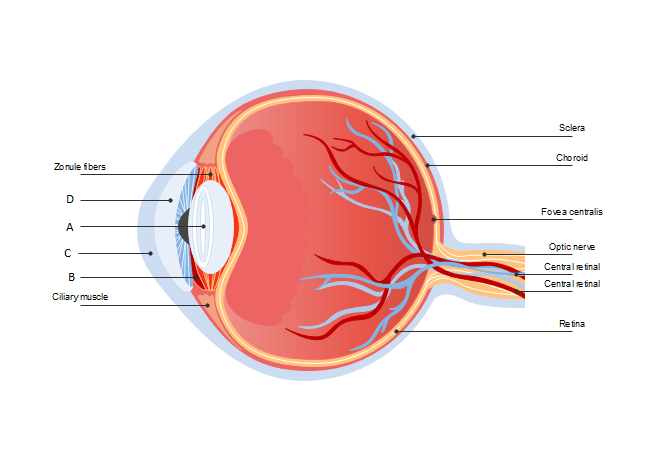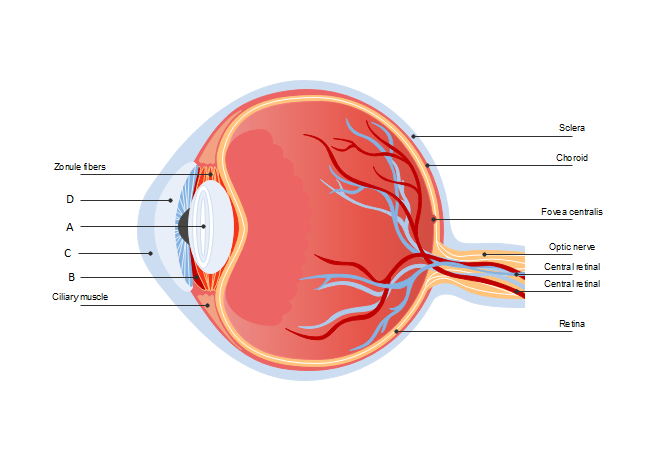Answer
406.2k+ views
Hint: Human eye is considered as a camera to see this beautiful world, what makes all this possible is light which first enters a thin membrane called cornea.
Complete step by step answer:
In the above diagram, there are various parts of eye represented by A, B, C, D

We will see each of them:
A. Eye lens:
a.) Eye lens or simply lens is the transparent body enclosed in an elastic capsule.
b.) Made up of protein and water.
c.) The eye lens forms an inverted real image of the object on the retina.
Retina is a membrane having an enormous number of light sensitive cells. These cells get activated when light illuminates them and generates electrical signals. These signals reach our brain via optic nerve, which makes life beautiful.
B. Iris:
a.) Iris is behind the cornea and is a dark muscular diaphragm that controls the size of the pupil.
b.) Pupils regulate and control the amount of light entering the eye.
C. Cornea:
a.) As we already hinted, the thin membrane through which light enters.
b.) It is also the outer covering of the eye lens.
c.) Most of the refraction of light rays occurs in the cornea.
D. Aqueous humour:
a.) It is a thin, transparent fluid similar to plasma. It is mostly made up of water and it contains very little part of sugar, vitamins, proteins etc.
b.) Fluids nourishes the cornea and the lens and gives the eye its shape.
Our answer is option C. Cornea.
Additional Information:
a.) Curvature of the eye lens is modified by ciliary muscles. Thus, you may have seen when we bring a bright light source near our eye, the lens contracts while in dim light it expands. This is done by ciliary muscles to control the amount of light.
b.) Minimum distance through which humans can see clearly is 25 cm. Also known as Least Distance of Distant Vision.
c.) The maximum distance we can see is infinite.
d.) There are some defects associated with the eye, these are: Cataract, Colour Blindness, Myopia, Hypermetropia, Presbyopia.
Note: To remember the different parts of eyes, students must make the pattern either from front to back or back to front. Personally I suggest from front to back as light enters into eyes from the front side.
Complete step by step answer:
In the above diagram, there are various parts of eye represented by A, B, C, D

We will see each of them:
A. Eye lens:
a.) Eye lens or simply lens is the transparent body enclosed in an elastic capsule.
b.) Made up of protein and water.
c.) The eye lens forms an inverted real image of the object on the retina.
Retina is a membrane having an enormous number of light sensitive cells. These cells get activated when light illuminates them and generates electrical signals. These signals reach our brain via optic nerve, which makes life beautiful.
B. Iris:
a.) Iris is behind the cornea and is a dark muscular diaphragm that controls the size of the pupil.
b.) Pupils regulate and control the amount of light entering the eye.
C. Cornea:
a.) As we already hinted, the thin membrane through which light enters.
b.) It is also the outer covering of the eye lens.
c.) Most of the refraction of light rays occurs in the cornea.
D. Aqueous humour:
a.) It is a thin, transparent fluid similar to plasma. It is mostly made up of water and it contains very little part of sugar, vitamins, proteins etc.
b.) Fluids nourishes the cornea and the lens and gives the eye its shape.
Our answer is option C. Cornea.
Additional Information:
a.) Curvature of the eye lens is modified by ciliary muscles. Thus, you may have seen when we bring a bright light source near our eye, the lens contracts while in dim light it expands. This is done by ciliary muscles to control the amount of light.
b.) Minimum distance through which humans can see clearly is 25 cm. Also known as Least Distance of Distant Vision.
c.) The maximum distance we can see is infinite.
d.) There are some defects associated with the eye, these are: Cataract, Colour Blindness, Myopia, Hypermetropia, Presbyopia.
Note: To remember the different parts of eyes, students must make the pattern either from front to back or back to front. Personally I suggest from front to back as light enters into eyes from the front side.
Recently Updated Pages
Assertion The resistivity of a semiconductor increases class 13 physics CBSE

Three beakers labelled as A B and C each containing 25 mL of water were taken A small amount of NaOH anhydrous CuSO4 and NaCl were added to the beakers A B and C respectively It was observed that there was an increase in the temperature of the solutions contained in beakers A and B whereas in case of beaker C the temperature of the solution falls Which one of the following statements isarecorrect i In beakers A and B exothermic process has occurred ii In beakers A and B endothermic process has occurred iii In beaker C exothermic process has occurred iv In beaker C endothermic process has occurred

The branch of science which deals with nature and natural class 10 physics CBSE

The Equation xxx + 2 is Satisfied when x is Equal to Class 10 Maths

What is the stopping potential when the metal with class 12 physics JEE_Main

The momentum of a photon is 2 times 10 16gm cmsec Its class 12 physics JEE_Main

Trending doubts
Difference Between Plant Cell and Animal Cell

Difference between Prokaryotic cell and Eukaryotic class 11 biology CBSE

Fill the blanks with the suitable prepositions 1 The class 9 english CBSE

Change the following sentences into negative and interrogative class 10 english CBSE

Summary of the poem Where the Mind is Without Fear class 8 english CBSE

Give 10 examples for herbs , shrubs , climbers , creepers

Write an application to the principal requesting five class 10 english CBSE

What organs are located on the left side of your body class 11 biology CBSE

What is the z value for a 90 95 and 99 percent confidence class 11 maths CBSE




